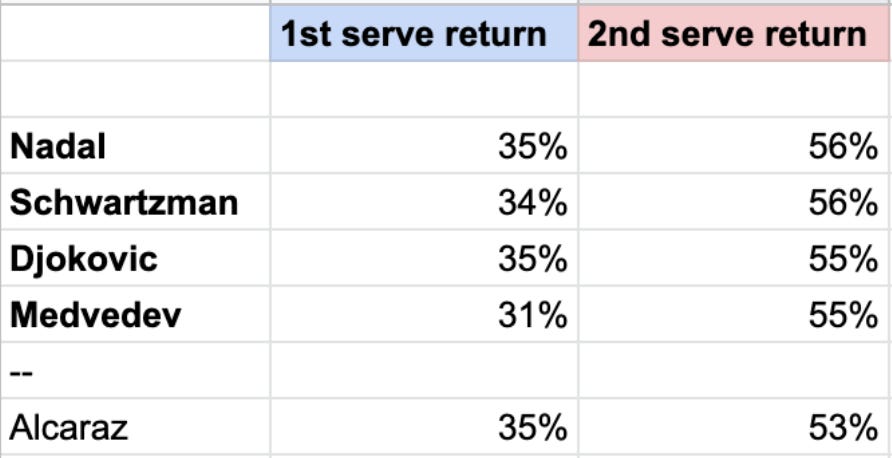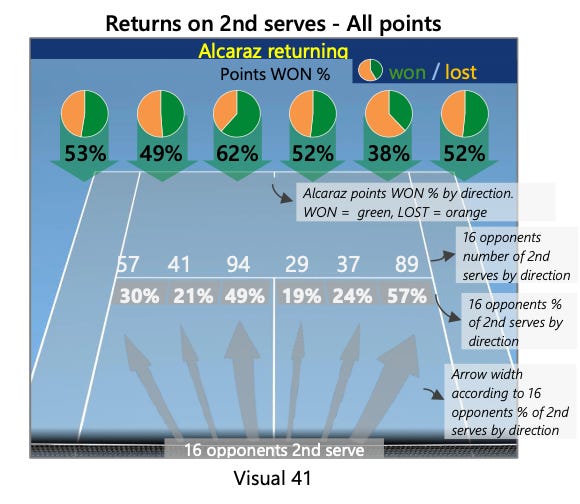Carlos Alcaraz Breaks Through
The 18 year old's ceiling is unknown, which is exactly what makes him exciting
Back to normal match analysis from Sunday onwards (Olympic issue). But today I want to focus on a special young player who had a big breakthrough yesterday.
18 year old Carlos Alcaraz won his first ATP title on Sunday, beating Richard Gasquet on the clay in Umag, Croatia. Alcaraz joins an illustrious list of young title winners since the 90’s:
1992 Genova - Andrei Medvedev (17y 9m 21d)
1998 Adelaide - Lleyton Hewitt (16y 10m 18d)
2004 Sopot - Rafael Nadal (18y 2m 12d)
2008 Delray Beach - Kei Nishikori (18y 1m 19d)
2021 Umag - Carlos Alcaraz (18y 2m 20d)
(credit to @youngtennisguns)
Alcaraz’s ranking has rocketed up over the past few years, from number 1427 in the world in 2018 (as just a 15 year old) to a new high this week of 55. Yesterday the young Spaniard was just 8 days older than his idol Nadal was when he won his first title. And the Nadal references don’t stop there:
Broke into Top 75 at age 18 on 21 June 2021, becoming youngest player to do so since 16-year-old Nadal on 19 May 2003.
Advanced to 2021 Roland Garros 3R as 18-year-old, becoming youngest player in a Grand Slam 3R since Nadal, 17.
Reached 1st ATP Tour semi final at 2021 Marbella as a 17-year-old WC, becoming youngest Spanish semi-finalist since Nadal, 17, at 2004 Auckland.
Beat Ramos-Vinolas in ATP Tour debut at 2020 Rio de Janeiro as 16-year-old WC, becoming youngest Spanish match winner since Nadal, 15, at 2002 Mallorca.
One of the most interesting and exciting things about Alcaraz is that there is clear and measurable progression. Many players from about 16-17 years old onwards discover their ceilings pretty quickly and either flame out of the tour or toil in ITF’s or Challengers for much of their careers. Alcaraz’s ceiling is still unknown because he’s steadily beating harder and harder competition as he works his way up the cut-throat ladder of professional tennis.
Challenger seasons:
2019: Played 13 - won 7, lost 6 (54% win rate). Best result = quarterfinal Seville.
2020: Played 24 - won 20, lost 4 (83% win rate). Best result = title x3.
2021: Played 7 - won 6, lost 1 (85% win rate). Best result = title.
Alcaraz in the past 2-3 years has done exactly what you’d hope a prodigious star would do: beating the Challenger level and is now mostly too good for that category.
Tour Level Seasons
2020: Played 2 - won 1, lost 1 (50% win rate). Best result = R16 in Rio.
2021: Played 25 - won 15, lost 10 (60% win rate). Best result = Title in Umag.
Alcaraz, after beating the Challenger level in 2020, took a massive step up in terms of main tour matchplay in 2021 so far. And he’s not exactly out of place at this level: a 60% win rate, with a title, in his first proper season on the main tour is extremely impressive.
This kind of progression at 16-18 years old is not particularly common these days and Alcaraz is still yet to hit that ceiling. The question now is how high his ceiling currently is, how high it can be pushed given his rate of improvement, and the relationship between those two questions.
Return of serve
To be quite clear, no player should be compared to Nadal (or any of the big 3). Alcaraz will forge his own path and should be judged on his own merits or shortcomings, even if eighteen year old prodigies out of Spain will inevitably draw some unfair comparisons. But racking up milestones like the above, at such a young age, definitely bodes well and somewhat breaks the mould of the recent trend of younger players maturing and breaking through slightly later in their career arc.
Meaningless comparisons aside, there actually *is* an interesting bit of performance overlap, relatively speaking, between Alcaraz and Nadal when it comes to a particular shot: the 2nd serve return. Nadal’s 2nd serve return is one of the best of all time (Nadal and Diego Schwartzman currently lead the 2nd serve return performance over the last 12 months at an average of 56% return points won), thanks to a devastating combination of putting a high number of returns in play (ie not offering up free points) and setting up neutral or advantaged rallies for return 1-2 punches. Nadal’s return, on clay especially, puts opponents in situations where if they miss that first serve they’re usually an underdog to win the point. That kind of pressure has been an invaluable part of Nadal’s greatness, and there are some quite particular signs that Alcaraz may have been paying attention to his idol.
If we look at the four best returners on the main tour, and Alcaraz, over the last 12 months we get this (all surfaces):
Alcaraz isn’t far off the very best returners in the game this year. These are elite numbers. And if you separate it out by opponent strength (main tour) things still look good:

The most interesting thing about the above is Alcaraz’ consistency and even improvement on his 2nd serve return performance as the opposition gets tougher. The sample size of top 20 opponents is too small to read much into (although it does includes elite servers) but those 50%+ figures are impressive and certainly not out of place at the very top of the tour. This year alone Alcaraz won 58% of his 2nd serve return points against Zverev (hard), 42% against Nadal (clay), and 58% against Medvedev (grass).
If you split it by surface you get this (main tour):
As above, Alcaraz has a very varied set of tools on the return that should serve him pretty well across all three surfaces. Clay is clearly his favourite and most frequent surface at this stage of his career, but he has the foundations in place to succeed on both slower and faster surfaces. On clay he can stand a bit further back and run around his backhand to load spin onto the server’s baseline a la Nadal:

And on faster surfaces he can stand in and hit flatter, punchier returns off both forehand and backhand a la Djokovic:

His favourite return
If we go even more granular, with serve and return direction, we get some really interesting stuff.
Alcaraz is devastatingly effective on return when the server hits their 2nd serve down the T on the deuce side. A 62% win rate on that type of return is enormous and is almost entirely thanks to a mix of ‘run-around’ forehands (GIF above vs Mannarino) and good backhand returns (GIF above vs Van de Zandschulp). Body 2nd serves, especially on the AD side seem like a good strategy for his serving opponents.
Perhaps the craziest thing about Alcaraz’s 2nd serve returns, down the T on that deuce side, though is that on pressure points (0-30, deuce, and all tiebreak points) he won 70% of return points on clay and hard courts against 16 opponents. And if Alcaraz managed to hit those 2nd serve returns to either corner, deeper than the service box, he was winning 80% of points.
Ceiling
Many parts of Alcaraz’s game are impressive. He has a solid serve (which can and should still be improved significantly), an excellent forehand and backhand, and, perhaps most obviously, incredible movement and baseline court craft. The reason I pick out his 2nd serve return however is that while all those aspects of his game look brilliant against challenger and non-elite main tour players, they usually take either slight or significant hits against elite opponents at this very raw stage of his career. But the 2nd serve return, and 1st serve return to a lesser extent, stays constantly impressive. The key when looking for indications of a player’s ceiling is which categories get hit and which categories stay constant when they meet better and better opponents. Alcaraz is going to get more and more opportunities to test his game against the guys at the top of the tennis ladder, and therefore more and more opportunities for all aspects of his game to improve in the face of the elite. But his 2nd serve return is pretty much already there.
So keep an eye on that part of his game as the rest of it tries to catch up. Carlos Alcaraz has very much arrived on the main tour, and, for now at least, the eighteen year old’s ceiling is still hidden in the clouds.
— MW
If you have any questions on the above, let me know in the comments. No question is dumb.
I’ll see you on Thursday
Twitter @MattRacquet
The Racquet goes out twice a week, a (free) topical piece every Thursday and a (paid) analysis piece every Sunday/Monday.
// Looking for more?
Top: Clive Brunskill/Getty
Bottom: Julian Finney/Getty









Nice read. I’m keen to see him on hard this Autumn before making a rapid judgement. I’m slightly concerned about that arm. He’s so young, don’t want a Bianca situation. Wld rather he played less and recouped more
Thanks, very interesting; always exciting to have a new talent to watch. 2 questions:
i/I've only watched him play twice but he seemed very aggressive, both in going for winners and in approaching the net. Do the stats bear that out?
ii/I think the hardest thing with a young player is to evaluate their mental ability. Just judging by watching scores, he seems to be winning alot of close sets. Do you have an opinion on this issue?